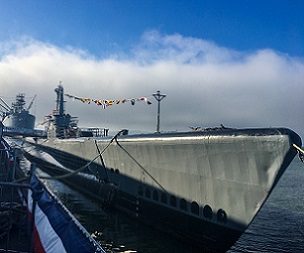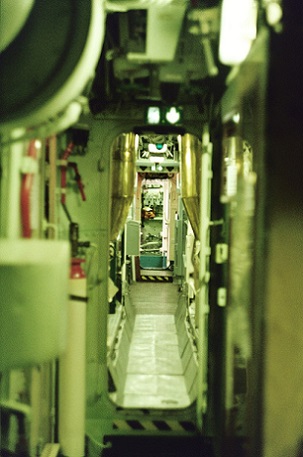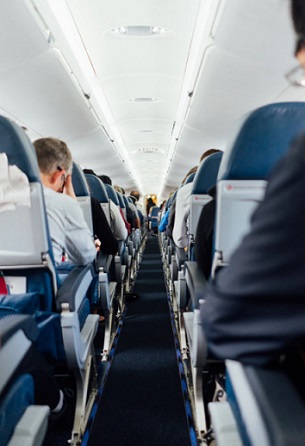 A submarine moored up. Photo by Thomas Haas on free photo website Unsplash.
A submarine moored up. Photo by Thomas Haas on free photo website Unsplash.
 The claustrophobic interior inside a submarine. Photo by Taylor Vatem on free photo website Unsplash
The claustrophobic interior inside a submarine. Photo by Taylor Vatem on free photo website Unsplash
 A pilot with an AvSax lithium battery fire containment bag
A pilot with an AvSax lithium battery fire containment bag
 The last place you’d want a lithium battery going into thermal runaway is on board a passenger aircraft
The last place you’d want a lithium battery going into thermal runaway is on board a passenger aircraft
Lithium batteries are used to power all our everyday electronic devices such as mobile phones and iPads … but what happens if they catch fire in the confined space of a passenger aircraft, a submarine or a train?
When lithium batteries overheat or catch fire they can cause a severe danger very quickly from toxic smoke or even explosions.
The last place you want this to happen is at 35,000ft feet in a passenger plane, hundreds of feet beneath the sea in a submarine, in an underground tube train or on a train travelling at speed, especially through a tunnel.
An explosion could seriously injure someone and cause catastrophic damage, especially to a plane.
When batteries catch fire like this it’s known as thermal runaway which happens when one cell in a battery overheats it can produce enough heat – up to 900°C (1652°F) – to cause adjacent cells to overheat.
This can cause a lithium battery fire to flare repeatedly and once they get going they are very difficult to put out. They can flare up minutes or even hours later.
Lithium battery fires can and do happen, far more frequently than people think.
For instance, there have been 10 lithium battery fire incidents on board aircraft in just one month in 2022 … including three on a single day.
These incidents were only reported if they happened in USA airspace or involved American passenger aircraft so there may have been many more worldwide.
Such USA-based incidents are catalogued by the Federal Aviation Administration in the US and show the unusually high number between June 22, 2022 and July 22, 2022.
Airline operators take the potential danger so seriously that lithium battery safety has now become a vital part of the pre-flight safety briefing. Passengers are warned that if their mobile phone or other personal electronic device overheats, starts to emit smoke or is lost in their seat they must alert a member of the cabin crew straightaway.
This is because the situation needs dealing with immediately and effectively. If the phone has been lost down a seat and the passenger shifts the seat to try to find it, the mechanism could crush the phone and send the battery into thermal runaway.
Many airline operators now have special lithium battery fire containment bags on board and the best-selling one by far is the award-winning AvSax (www.avsax.com) which are now on more than 16,770 aircraft operated by more than 100 airline companies worldwide.
They have been used 33 times to deal with emergencies since the start of 2017 and every time they have been deployed the aircraft has been able to complete its journey safely with no need to divert or make an emergency landing.
AvSax won the prestigious Queen’s Award for Enterprise in the UK in 2018, the highest award any business can get.
Many air ambulance helicopters in the UK now carry AvSax. More than 20 helicopters operated by specialist aerial emergency medical services company Babcock were equipped with AvSax following a detailed look into the possible risks posed by lithium-ion batteries on aircraft.
AvSax were invented by Richard Bailey, managing director of innovative company Environmental Defence Systems Ltd based in Yorkshire, UK, who said: “We are getting interest in the AvSax from new markets, especially those that operate in confined spaces such as submarines and underground trains where the last thing you’d want is a lithium battery fire.
“The use of lithium batteries will continue to grow and so will the risks. They are a very convenient and effective way to power our everyday personal electronic devices but there is a danger to them and when they catch fire they’re very difficult to put out.”
The AvSax is a heavy duty bag made from military grade material which can withstand the force of a blast if the device explodes once it’s inside the bag.
The crucial way the AvSax works is that it cools the overheating device. This is done by adding at least 2 litres of water into the bag once the device has been put in there. The water is absorbed into the sides of the AvSax which close around the device and smother it.
This use of liquid is recommended by the Civil Aviation Authority in the UK and many other fire containment bags don’t work this way.
In its guidance the CAA states: “Since the development of the International Civil Aviation Organisation (ICAO) guidance on dealing with an in-flight battery fire, new products designed for use in response to lithium battery thermal runaway events have become available.
“Products which provide both a cooling and containment capability are typically more aligned to the existing ICAO guidance as when used they are filled with water or other non-flammable liquid to act as a cooling agent.
“After knocking down flames it could conceivably take just a couple of seconds for a personal electronic device to be placed inside a containment bag, allowing it to be moved to a place of safety. Passengers could then return to their seats, mitigating potential unrelated safety hazards such as injury in the case of severe turbulence. Equally, the effect on flight crew in carrying out their duties following an event on the flight deck would be minimised.”
Fires are a major hazard in the recycling industry with about half now caused by lithium-ion batteries being damaged or crushed, sending them into thermal runaway.
Recycling companies are looking at AvSax technology to try to reduce the risk.
A special projects section at Environmental Defence Systems is now working with a university experts on a prototype device to help douse battery fires on electric vehicles. At the moment they burn at such a phenomenally high temperature firefighters tend to stand back and let the fires burn themselves out.
The batteries are inset into the bottom of electric vehicles and so often damage the road surface with the searing heat once they catch fire. The prototype device will stop this from happening and also smother the flames and heat, allowing the electric vehicle fire to be dealt with more quickly and effectively.